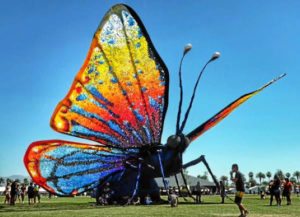After you have reviewed these materials click on Mark Complete at the bottom of this page to continue.
Idea to Explore
What would happen if insects were the same size as humans? How can we create life-size butterflies to use in our projects?
The main focus of this project was to investigate the relationship that we have with animals. How would life carry on if our insects were the same size as us? Would their habitats change?

Discover
We told the pupils that they were scientists and that we needed their help to create a new species of butterfly. The aim was to create butterflies ten times their original size. First, they had to research the body of a butterfly because otherwise, the butterflies would be mutants, and we only wanted perfectly sized butterflies.
Define
Next, the pupils looked at a stuffed butterfly and different pictures of butterflies. Each country looked at species that were very common in the area they live in. The pupils were asked what they could see e.g. How many wings does a butterfly have? What does the head of the butterfly look like? What kind of colours does a butterfly have on its body? Why would it have these colours?
Develop
Afterwards, the pupils were divided into four groups and were asked to measure the body parts of the butterfly. Next, they contemplated what they should do with the measurements in order for them to be able to build a butterfly that was ten times the original size. They figured out that the answer to that was to multiply and then they were ready to build the butterfly.

Following that, the pupils were told to make a design draft and consider which materials they were going to use and how their butterfly should look. We provided enough materials so the students could choose from a variety of building materials.
Deliver
After finishing their work on the butterflies, the pupils presented their butterfly to each other in the classroom. The process was evaluated through asking the pupils questions such as: What was it like measuring the body parts of the butterfly? Was it difficult upscaling the butterfly? Was it difficult working in a group? what have you learned from working on this project?




The pupils then drafted a film script using their large butterfly as inspiration for the main character. The film scripts were swapped with another country, and the children created a film on the basis of the film scripts.


International Collaboration
The pupils showed what they had made in a Skype meeting and talked about the differences they could find. What does a butterfly look like in England, Norway, Denmark and Belgium?
Creation and swapping of film scripts and films.
Reflection
Has the other country created a film based on script as we imagined?
Resources
- Photos of butterflies that are known in the area you live.
- Green screen, movie maker, iPads or Android devices (Greenscreen by DoInk and iMovie apps)
- Wood, chicken wire, paper, wallpaper glue, old papers
- Paper, fabrics, paint
- Stuffed butterfly
STEM to STEAM Analysis
Science: Researching the body parts of a butterfly.
Technology: Making a movie with green screen techniques.
Engineering: Designing and creating the body of a butterfly with different kinds of material that can move and be used in a film.
Art: Decorating the wings.
Mathematics: Making a butterfly ten times it’s natural size. Pupils have to make calculations and work with scale.
After you have reviewed these materials click on Mark Complete at the bottom of this page to continue.
